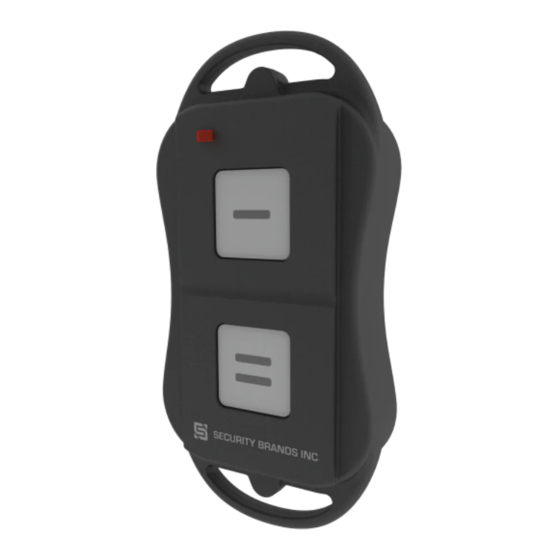
Table of Contents
Advertisement
Quick Links
INSTRUCTIONS
IN THE BOX
Make sure you have everything shown here.
This remote must be paired to and used
with a Security Brands Ridge 2.0 Transceiver
(Model 14-REC20) to work correctly.
WHAT'S WHAT
The Ridge Remote has two programmable buttons and
a status LED. Each button can be paired to a separate
modes of operation.
BASIC SETUP
1. On Ridge 2.0 Transceiver, hold down
PROGRAMMING PAIR button for three seconds
and release. PROG LED will light up.
NOTE: The transceiver must be powered up and
have its cover removed for this step. Please see the
instructions that came with it for help.
2. On Ridge Remote, press and hold down both
buttons and pay attention to remote LED.
RIDGE REMOTE (433 MHZ)
Button 1
Button 2
1 of 2
Ridge Remote
LED
PROGRAMMING PAIR
Button
PROG LED
Model 14-R433
Visor Clip
Advertisement
Table of Contents

Subscribe to Our Youtube Channel
Summary of Contents for Security Brands 14-R433
- Page 1 RIDGE REMOTE (433 MHZ) Model 14-R433 IN THE BOX Make sure you have everything shown here. This remote must be paired to and used with a Security Brands Ridge 2.0 Transceiver (Model 14-REC20) to work correctly. Ridge Remote Visor Clip WHAT’S WHAT The Ridge Remote has two programmable buttons and a status LED.
- Page 2 If it is not, check the battery. If it still does not techsupport@securitybrandsinc.com respond, complete the pairing procedure again. Two-Year Limited Warranty Visit securitybrandsinc.com/warranty/ for details © 2021 Security Brands, Inc. All rights reserved. 2 of 2 I-14R433-EN Rev. B (10/2021)
- Page 3 FCC Statement: Any Changes or modifications not expressly approved by the party responsible for compliance could void the user’s authority to operate the equipment. This device complies with part 15 of the FCC Rules. Operation is subject to the following two conditions: (1) This device may not cause harmful interference, and (2) This device must accept any interference received, including interference that may cause undesired operation.




Need help?
Do you have a question about the 14-R433 and is the answer not in the manual?
Questions and answers